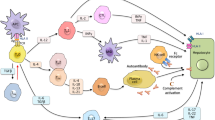Summary
We clarified the clinical and immunogenetical differences between patients with autoimmune hepatitis (AI-CAH), and patients with type C chronic active hepatitis (C-CAH) and type B chronic active hepatitis (B-CAH) who were positive for autoantibodies and hyperglobulinemia. While histories of blood transfusion, intravenous drug abuse and tattoo were seen frequently in patients with type C-CAH, they were rare in patients with AI-CAH. The severe subjective symptoms including anorexia, lethargy, icterus, high fever and extrahepatic manifestations, and severe abnormality of biochemical data were seen in AI-CAH predominantly. Ongoing or past infection of HCV was seen in only 14% of patients with AI-CAH. HLA-DR4 was the most frequently associated with AI-CAH (89%) and 6 DR4-negative patients were positive for DR2. HLA-DNA typing showed that there was no significant difference in the frequency of DR4-associated Dwalleles between the patients and controls who were positive for DR4. These findings suggest that the basic amino acid at position 13, which is present only on the DR2 and DR4 B1 molecules (Arg on DR2 and His on DR4), may contribute to the susceptibility to autoimmune hepatitis of Japanese. Thus, we conclude that AI-CAH is a genetically restricted, disease, and different from CCAH which is a viral infectious disease.
Similar content being viewed by others
References
Bassetti D, Cutrupi V, Dallago B, et al. Second generation RIBA to confirm diagnosis of HCV infection. Lancet 1991;337:912–913.
Esteban JI, Esteban R, Viladomiu L, et al. Hepatitis C virus antibodies among risk groups in Spain. Lancet 1989;2:294–297.
Lenzi M, Johnso PJ, McFarlane IG, et al. Antibodies to hepatitis C virus in autoimmune liver disease: evidence for geographical heterogeity. Lancet 1991;338:227–280.
Lenzi M, Ballardini G, Fusconi M, et al. Type 2 autoimmune hepatitis and hepatitis C virus infection. Lancet 1990;335:258–259.
Todd JA, Bell JI, McDevitt HO. HLA-DQ beta gene contributes to susceptibility and resistance to insulin-dependent diabetes mellitus. Nature 1987;329:599–604.
Nepom GT, Hausen JA, Nepom BS. The molecular basis for HLA class II associations with rheumatoid arthritis. J Clin Immunol 1987;7:l-7.
Sherlock S. Disease of the Liver and Biliary System (eight edition). London; Blackwell Scientific Publications, 1990;348–356.
Okamoto H, Okada S, Sugiyama Y, et al. The 5−terminal sequence of the hepatitis C virus genome. Jpn J Exp Med 1990;60:167–177.
Ota M, Seki T, Fukushima N, et al. Modified PCR-RFLP method for HLA-DRB1 genotyping. Tissue Antigens 1991;38:60–71.
Nishiguchi S, Kuroki T, Ueda T, et al. Detection of hepatitis C virus antibody in the absence of viral RNA in patients in patients with autoimmune hepatitis. Ann Intern Med 1992;116: 21–25.
Mackay IR, Morris PJ. Association of autoimmune active hepatitis with HLA A1,8. Lancet 1972;ii:793–795.
Opelz G, Vogrten AJ, Sunnerskill WH, et al. HLA determinants in chronic active liver disease: possible relation of HLA-Dw3 to prognosis. Tissue Antigens 1977;9:36–40.
Tait BD, Mackay IR, Board P, et al. HLA Al, B8, DR3 extended haplotypes in autoimmune chronic hepatitis. Gastroenterology 1989;97:479–481.
Seki T, Kiyosawa K, Inoko H, et al. Association of autoimmune hepatitis with HLA Bw54 and DR4 in Japanese patients. Hepatology 1990;12:1300–1304.
Seki T, Ota M, Furuta S, et al. HLA class II molecules and autoimmune hepatitis susceptibility in Japanese patients. Gastroenterology 1992;103:1041–1047.
Author information
Authors and Affiliations
Additional information
This study was supported by a Grant-in Aid from the Ministry of Health and Welfare and by a Grant-in-Aid (No. 03454227) for Scientific Research from the Ministry of Education, Science and Culture of Japan.
Rights and permissions
About this article
Cite this article
Kiyosawa, K., Seki, T., Tanaka, E. et al. Comparison of the clinical and immunogenetic features between patients with autoimmune hepatitis and patients with type C chronic active hepatitis. Gastroenterol Jpn 28 (Suppl 4), 63–68 (1993). https://doi.org/10.1007/BF02782892
Issue Date:
DOI: https://doi.org/10.1007/BF02782892




